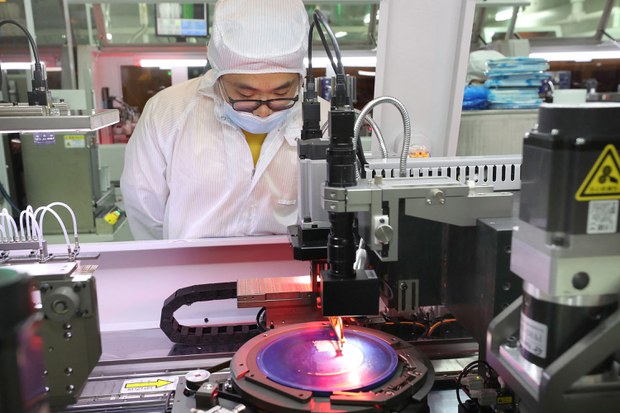Even with CHIPS Act, U.S. industry could take ‘years’ to catch up
Share

An employee makes chips at a factory of Jiejie Semiconductor Company in Nantong, in eastern China’s Jiangsu province on March 17, 2021.
It could take five years for manufacturing facilities subsidized under the Biden administration’s $280 billion CHIPS Act to come online, with tens of thousands of new specialist engineers needed before the U.S. domestic semiconductor industry catches up with Asia, experts and officials say.
The CHIPS Act, which President Joe Biden signed into law on Aug. 9, aims to coax American computer chip producers like Intel, Micron and AMD into moving more production back to the U.S., as concerns grow about the national security risks of relying on China to supply the goods.
It earmarks $52.7 billion in subsidies for companies to carry out research and manufacture the chips domestically. Beijing has said it is “firmly opposed” to the legislation, which it said reflects a “Cold War mentality.”
Yet even with the new subsidies, “it will be years before these manufacturing facilities go fully online,” Sen. Mark Warner (D-Va.) said at a Washington Post virtual event about the CHIPS Act on Thursday.
“It will take three to five years to even build these out — in some cases even longer,” said Warner, who chairs the Senate Intelligence Committee and whose state is home to key chipmakers. But he said the subsidies were needed to help shore-up America’s production capabilities.
“If we hadn’t done this legislation, if this was not the law of the land, the one thing I could say unequivocally: None of these facilities would be in America, because it is cheaper to build in Asia,” he said.
The global share of chips manufactured in the U.S. has fallen to just 12% today, from 37% in 1990, according to the Semiconductor Industry Association. The bulk is now produced in Asia, with lawmakers like Warner expressing concerns about the potential impacts on the U.S. military and broader economy if supply was cut.


Engineer shortage
But the efforts to revive U.S. chipmaking capabilities are not meant to decouple American and Chinese industries, experts say.
“Self-sufficiency in semiconductors isn’t viable for any country, including the U.S. and China,” said Scott Kennedy, an expert in Chinese business and economics at the Center for Strategic and International Studies.
“I don’t think that’s the purpose of the U.S. government’s efforts,” he told RFA. “Instead, it is looking to reduce its over-dependence on overseas production and other parts of the supply chain. That means some modification of global supply chains, but not an elimination.”
Carol Handwerker, a professor of materials engineering at Purdue University in West Lafayette, Indiana, who teaches students that go on to work in the industry, said the CHIPS Act was about ensuring the United States builds back the capability to produce world-class chips.
Part of that, she told RFA, would come down to training more engineers.
“We don’t have enough people going through our programs right now to meet the needs,” Handwerker said. “The estimate is about 80,000 new engineers in five years. That’s a lot of people in a short period of time.”
Even within firms, she noted, training workers could be an arduous and yearslong task, with orders for manufacturing equipment themselves taking more than two years to even arrive. To circumvent the wait, firms are sending workers to Taiwan “to train them so that when the facility here is in operation, they’ll be able to operate the equipment.”
Gap in knowledge
But Handwerker said the industry’s “top schools” — the Massachusetts Institute of Technology, University of California-Berkeley, Stanford and Purdue — also likely need to do more to train the labor force.
“I’m from Purdue, and we’re training engineers at the undergraduate, master’s and PhD level, and I think we’re providing an excellent education,” she said. “What we’re hearing, though, is that even for all of us at the top tier, when companies are putting out job descriptions, there’s a gap between what the students know and what the companies need.”
To help keep talent in America the Biden administration on Oct. 7 also unveiled export controls that ban U.S. citizens and permanent residents from supporting the “development or production” of chips in China.
Chinese firms have said the restrictions will introduce instability, and the China Semiconductor Industry Association slammed the United States for “abruptly disturbing international trade in such an arbitrary way.”
“Not only will such unilateral measures further harm the global supply chains of the semiconductor industry, more importantly it will create an atmosphere of uncertainty,” the trade association said on Oct. 7.
The rules are expected to affect hundreds of Chinese Americans, according to Nikkei Asia, including executives of some of China’s biggest chipmakers, many of whom worked for decades in the United States before returning to China under its “Thousand Talents” program.
But bringing more outsiders into the industry over coming years will also be needed to fill the tens of thousands of estimated job vacancies.
Speaking at the same event as Warner on Thursday, Indiana Gov. Eric Holcomb, a Republican, noted that the bipartisan push to revive the U.S. chip industry could face limits due to its extensive labor requirements amid what he described as “peak private sector employment” levels.
“Fortunately, for the state of Indiana, our population is growing,” Holcomb said. “We’re going deep into the bench, into the ‘farm team’ if you will, into high schools, and actually building programs, pathways and pipelines.”
The chipmaking industry’s ability to attract top high school and college talent could make or break the successes of the CHIPS Act, he said.
“We have to have world-class research and development. Universities like Purdue and Notre Dame and Indiana University, and our community colleges — all these pieces snap together to form talent pipelines that will be necessary on Day One, which was yesterday,” Holcomb said.
“We have slipped, we have fallen behind, and we have a lot of ground to make up. This has to do equally with our national security and with our economic security. They go hand-in-glove.”







